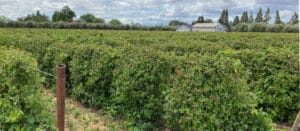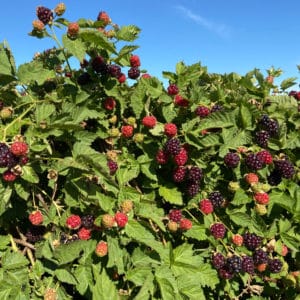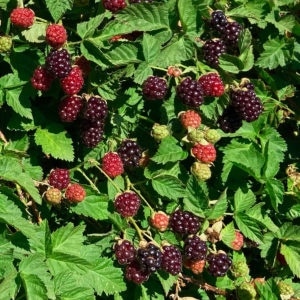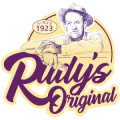
Nettie's Boysenberry Blog
Hi, I’m Jeanette Boysen Fitzgerald, and I grow heritage boysenberries at Boysen Berry Farm in Orland, CA with my husband, Tom. Our heritage vines were propagated from the original boysenberry vine, kept in the Boysen family for over 100 years. My grandfather, Rudy Boysen, originated the boysenberry in Napa, CA in 1923.
In this boysenberry blog I share personal experiences and insights and draw on research by experts and historians as well as family knowledge.
Read more, ask questions, and share your comments about boysenberries covering topics such as where the boysenberry came from, various how-to’s, recipes, and articles about Rudolph Boysen, the developer of the boysenberry.
Please post your questions and comments. I would love to hear from you!
Our Story
Our boysenberry story began in June 2016 when I took a solo camping trip to San Onofre State Beach just south of San Clemente, CA. Normally Tom and I always camped together in our 12-man “Hilton” tent at this, our favorite SoCal campground. The cliff sites were situated high above pounding surf, with beaches that boasted the best 3-mile stretch of beach combing we’d ever scouted.
I had decided to solo camp only because Tom’s business required extra attention at home in Las Vegas. Already across the desert that first morning by 10:30am, I parked in front of The Bagel Shack, our favorite San Clemente breakfast destination. Devouring a “San O” bagel was all I had in mind when my phone rang, “Caller Unknown.”
The Phone Call
It was a phone call I will never forget, the call from Chris Jepsen, who identified himself as a historian for the Orange County CA Archives. His first question was, “Are you the granddaughter of Rudy Boysen?”
A big grin spread over my face as I answered, “Why, yes, I am! What would you like to know about my grandfather?” Chris told me he was co-writing an article with Anaheim, CA historian Steve Faessel about Rudolph (Rudy) Boysen and the history of the boysenberry. Did I have any family stories about Rudy that I could tell him?
The surprise of it all would sustain my huge smile the rest of the day, but right then, my stomach insisted on consuming a San O’ bagel. I asked Chris if I could call him back in an hour after I’d gotten to the campground to set up my tent. Of course, he agreed.
He was just so happy he’d found me! Anaheim archivist, Jane Newell, had assisted Chris in tracking me down. So here it was: my father, Robert Boysen, was Rudy and Margaret Boysen’s only son, and Chris was co-writing an article about my Grandpa Rudy, inventor of the boysenberry!
I had no idea that less than two years later Tom and I would sell our spacious 2400 sq. ft., Las Vegas, NV home, buy 10 acres of prime farmland in Orland, California, and become growers of Rudy’s heritage boysenberries!
Chris Jepsen’s phone call in June 2016 set in motion the life-changing chain of events that led Tom and me to where we are today: living in a 400 sq. ft., 1998 King of the Road fifth-wheel RV, The Rig, that we bought for $1.00 from our dearest friends John and Joyce Kulp. We christened our 10-acre property Boysen Berry Farm on February 16, 2018.
To commemorate the event, we marked a new cement well-slab with our new farm’s name, the date, and our handprints! Three years later I’m still grinning ear to ear as I look out the front window of The Rig (as we call it) and see our boysenberry vines on the trellis lines, robust and healthy!
Discovering Family Vines
When Chris Jepsen asked for help with the boysenberry article in 2016, I provided him with photo albums and horticultural scrapbooks Grandpa Rudy had put together from his early 1900s school years on through the 1940s. It was Chris and Steve Faessel’s thorough research, however, that led Chris to discover an original boysenberry vine, the descendants of which are now growing on our farm.
Chris followed a clue from a June 20, 1958 Napa Register clipping entitled “Beginning Here for Boysenberry.” He already knew the Rudy’s boysenberry began in the Napa area known as Coombsville back then, but he read on to the end which related Margaret Boysen, widow of the late Rudy Boysen, “developer of the luscious berry” had visited Rudy’s younger brother, Leland Boysen, in Merced, CA on June 10, 1958.
The clipping’s final sentence held the clue: “…Margaret Boysen visited the home of her husband’s brother at Merced, where the original Coombsville vine is still growing and producing berries. Her brother-in-law had moved the vine there in 1955.” This got Chris to wondering. Could there be a Boysen relative still growing the original transplanted vine? The question sent Chris on a relentless hunt to find out.
Chris contacted Leland Boysen’s three granddaughters and inquired about Leland’s transplanted vine. Was it still growing in Merced? The sisters weren’t sure, but remembered growing up picking boysenberries every year from the vine in Grandpa Leland’s backyard, and then selling them from a card table he’d set up in front of his house.
Granddaughter Carrie also recalled that her Grandma, Augusta “Gussie” Boysen, had given away some starts from the original boysenberry vine at her wedding in 1976. Maybe someone from the wedding might still be growing boysenberries from those starts they received so long ago, but she doubted it. Chris was dogged. Who had received those vines?
Chris’s hunt finally paid off when he tracked down Alice Masek, a family member who had been given some root starts at Carrie’s 1976 wedding. Yes, Alice recalled, a very nice older family member had given her the root-starts. She took them home, planted them, and they were still growing and producing boysenberries in her backyard in Castro Valley, CA, near San Francisco.
When Chris emailed me with this news on July 3, 2016, I had tears streaming down my face, I was filled with joy! Chris provided Alice’s address and I emailed her right away.
I introduced myself, with the starting line, “This might be one of the more unusual emails you will get this year. My name is Jeanette (Boysen) Fitzgerald. I am the granddaughter of Rudy Boysen…” and after giving her a few more details, came right out and told her I would like some cuttings from her backyard vines. I didn’t beat around the bush.
Meeting Cousin Alice
Alice responded a few hours later and explained her husband, Mike Masek’s brother, Paul Masek, joined the “Boysen” family when he married Carrie Shook Masek, Leland Boysen’s granddaughter, in January 1976.
Alice continued: “I don’t even remember the grandmother’s name, only that she was very sweet and had a shoebox with boysenberry root cuttings and declared at the wedding we were “in the family,” so she could share them with us, but that we were not to propagate them or share them with others (EXCEPT other members of the family, so you qualify!)”
Alice also generously offered to meet Tom and I halfway with some vine cuttings, but we eventually all agreed on an August visit to Mike and Alice’s home instead. Alice and Mike were to become our close friends after that initial email and hundreds of emails between Alice and me since.
Tom and I set up grow lights for the clippings we would take at our visit. Unfortunately, after getting them home, every single cutting slowly died after a few weeks and none produced any roots.
Had we done more research, we would have learned boysenberries must be propagated a certain way, either by root-starts or by dipping the tip of a growing cane into the soil and leaving it connected to the “mother vine” for at least two months until it develops a root system, before transplanting it during dormant season in winter.
The Fallbrook Connection
In August 2016 I hosted a small reunion in my Las Vegas, NV home with church friends I grew up with in the 1970s in Oceanside, CA. We’d all found each other on Facebook after many years apart. Joni Cyr, one of my guests at the reunion, had just bought a vineyard in Fallbrook, CA. She literally had just closed the deal on the vineyard (by phone in my living room) during the reunion.
She rejoined us as I was telling the story about our boysenberries, and she said what perfect timing this was. She said, “Jeanette, I have a vacant spot in my new vineyard and want you to grow your boysenberries there.” (It was a 4 ½ hour drive from Las Vegas, but with perfect weather, good soil, and no place else to grow them…)
When I asked her how I could repay her, Joni said, “I don’t want anything, Jeanette, I just love you and want you to have a place to grow your boysenberries.” Joni was opening a door that eventually led us to where we are today.
Over the next few months, on into fall 2016, Cousin Alice put in tip starts in her backyard to prepare for a winter planting. When the time came, on January 15, 2017 Alice and Mike dug up the tip starts as well as some root-starts, loaded their Jeep with a full wheelbarrow and made the 10 hour drive down to Fallbrook.
They helped Tom and I plant the starts in a bed we’d prepared for 24 boysenberry vines. We had even purchased root cages to protect the vines from gophers, and prepared and installed an 8-inch deep, three foot high rabbit fence all around the 16’ x 80’ boysenberry patch.
Tom had designed and installed a solar powered automatic drip irrigation system to regularly water the vines. We made the 4 ½ hour drive back and forth about twice a month to take care of the patch.
Family Legacy
I named each of the 24 vines after family members and friends and monitored their growth every time we visited the boysenberry patch. We followed directions for growing boysenberries I found online, and in July 2017 we began tip-starting. Tom and I also started looking for land throughout California and Oregon, using the UCDavis soil survey website and Realtor.com to find possible sites to grow more boysenberries.
Tom had convinced me to fully embrace Grandpa Rudy’s legacy; it is a huge part of my heritage. Tom encouraged me to take the huge risk of starting our own boysenberry farm. It meant selling our house, developing a brand, and buying the perfect land to grow boysenberries. The long-term goal would be to also propagate and sell the vines, and to get them growing in as many backyards as we could.
Searching For A Farm
Throughout the summer and on into November 2017, Tom and I (mostly Tom) propagated over 950 tip-starts from the original 24 vines. We had not yet found suitable land at a price we could afford and continued our search.
January 2018 arrived and we were still searching. We’d found a 15-acre organic farm with the perfect soil type for $150,000 in Oregon and made a full price offer, but the owners decided to take one more shot at staying together and took the beautiful farm off the market.
Tom and I decided we really wanted to stay in California anyways because on average California has 100 more sunny days per year than most places in Oregon. Many of the California listings we looked at that had the perfect soil type, however, also had a moratorium on any new agriculture due to longstanding drought in the Central Valley.
Tom continued his research and found that farmers in the town of Orland, CA use flood irrigation from two reservoirs to water their crops: Orland had the cheapest water in the State. We were well into January with no Orland prospects except one 10-acre plot with perfect soil we’d found a few months earlier, but the owner had priced his land out of our financial reach.
Just across the street from the ideal 10-acre plot was a vacant 5-acre piece of property, sheltered from the drying winds by tall trees. Maybe we could lease the land. I found out who owned the property and wrote the owner about our project, requesting a possible lease. She called me as soon as she got the letter, and although she didn’t want to lease the land, she was extremely knowledgeable about farming and became an immediate friend and future neighbor.
We Found Our Farm
It was February 1, 2018 and we were running out of time. We had 950+ starts, but nowhere to plant them. Joni and her husband offered to let us lease some of their land, but leasing just didn’t seem wise to us, so Tom and I decided to make another offer on the perfect land in Orland that was priced higher than we could afford. The owner came back with a counter-offer, and we had a deal!
The Surprise
That evening, the owner informed the alfalfa farmer who was leasing the land that he had a buyer who was going to grow boysenberries. The alfalfa farmer informed the owner he had sprayed the property that afternoon with a powerful herbicide that lasts two years. It kills or slows the growth of all plants except alfalfa.
The Solution
When Tom and I received this news a few days later, we called the herbicide manufacturer for more information and he warned us that the herbicide is deadly to all blackberry plants, of which boysenberry is a hybrid. He strongly discouraged us from trying to grow boysenberries on the treated land.
Tom and I were out of options for a place to grow all the Fallbrook starts, and they were ready for transplanting. Tom suggested that we buy the Orland property and replace the dirt surrounding every start. We could rent an auger, dig a three-foot wide hole, and fill each hole with a 70/30 compost/soil mix.
That’s exactly what we did after we purchased the property on February 16, 2018. Tom also rewired the old non-functioning electrical box full of old wasps’ nests, arranged to pull and re-plumb the 40 ft. deep well, and prepared the old septic tank for use. Our friend, John Kulp, then towed The Rig from his place in Idaho to Las Vegas where he picked up Tom. The two set off for the ten-hour drive to the farm in Orland, and John helped Tom set up The Rig on our new property one week before our spring break transplanting trip.
Planting Begins
The last week of March was the final window to safely transplant bare-root tip-starts. My friend, Edna “Eddie” Dalton, helped us dig up over 600 starts from the Fallbrook boysenberry patch, and rode with us the twelve hours north to the farm in Orland. Alice and Mike met us there and helped us plant every other hole, leaving room in between for propagating and expanding the 1 ½ acres we’d prepared.
Continuing Rudy’s Legacy
Today we have 2,400 boysenberry vines that thrive in the rich Orland soil. With just the two of us, Tom and I strive to keep up. We started our own brand, Rudy’s Original boysenberry products, and built a website that includes my blog with helpful hints and recipes, plus stories about Grandpa Rudy Boysen and the history of the boysenberry.
We’ve also added a web store that features our Rudy’s Original Heritage Boysenberry jams, syrups, and plants.
We can’t wait for our third U-Pick harvest in May 2021. Like last year, tons of the boysenberries will be huge, the size of Rudy’s thumb (as he liked to describe them). And the taste surpasses all expectations. Today’s commercial boysenberries don’t compare.
We’ve rediscovered why everyone went crazy for boysenberries back in the 1930s when they were first marketed. My son, Rudy’s great-grandson, Mark VanSumeren, put it best after he tasted his first mouthful of boysenberry jam: “Tastes like heritage!” Yes, it does!
Many Thanks
I have Chris Jepsen to thank for starting this awesome adventure with that first inquiring phone call in 2016. I have Chris and Steve Faessel to thank for co-writing their comprehensive article about Grandpa Rudy and his boysenberry.
I have Alice and Mike Masek to thank for keeping Rudy’s legacy going and growing in their backyard. Most of all, I have my husband, Tom, to thank for recognizing my unique heritage and this opportunity to reintroduce the world to Rudy’s Original Heritage Boysenberry.
How To Articles

How to Prune Boysenberries
How to Prune Boysenberries This summer at Boysen Berry Farm we’re making next year’s harvest top priority. If you grow our Rudy’s Original Heritage Boysenberries

How to Grow Spectacular Boysenberries
How To Grow Spectacular Boysenberries Did you know the boysenberry was named after Rudolph Boysen, the inventor of the boysenberry? He loved to experiment with

How To Plant Bare-root Boysenberries
How To Plant Bare-root Boysenberries This article will walk you through how to plant bare-root boysenberries, including a few basic things to know about the plant,
REFERENCES
Carter, K. A., Zurn, J. D., Bassil, N. V., Finn, C. E., & Hummer, K. E. (2019). The Importance of Being ʽBoysenʼ: Examining Genotypic Variation With SSR Markers. Journal of the American Pomological Society, 73(1), 47-52.
Hummer, K., Carter, K., Zurn, J., Finn, C., Bushakra, J., & Bassil, N. (2019). Will the Real ‘Boysen’ Please Stand Up? The Bramble: Newsletter of The North American Raspberry & Blackberry Association, 34(2), summer 2019, 13-15. Retrieved from https://www.raspberryblackberry.com/wp-content/uploads/narba19-06news.pdf
